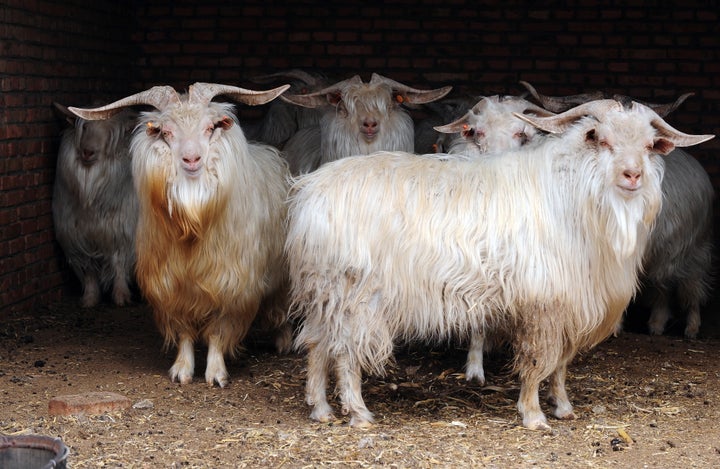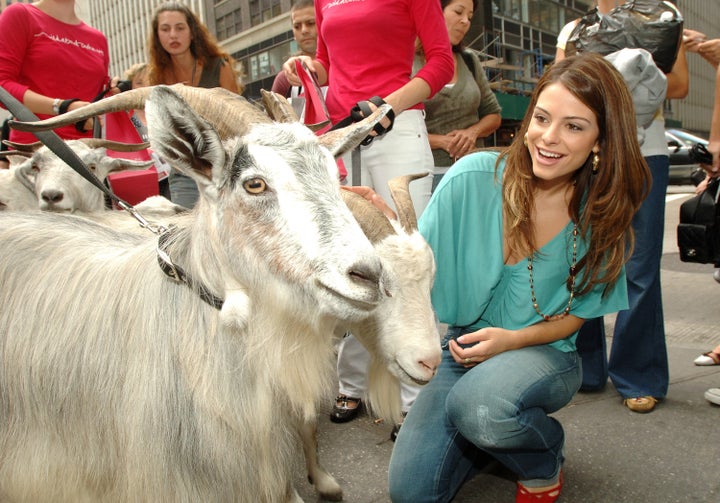There’s nothing quite like the soft touch of cashmere on your skin. It’s hard to imagine that the impossibly soft material is made from anything besides the threads of clouds and rainbows ― and it’s usually so expensive that you’d believe it if it were. But do you actually know what it’s made from?
Shockingly, it’s not clouds or rainbows. It is made from goats. Yes, you read that correctly. Cashmere comes from cashmere goats, the only animals that can produce those dreamy, luxurious, highly coveted fibers.

Pam Haendle, a cashmere goat farmer in Central New York, started farming cashmere goats after retiring and has anywhere from between 55 goats in the winter to 90 in the summer on her farm. She provided some insight as to why cashmere goods are so expensive.
“A single cashmere goat does not produce a whole lot. You only harvest the fibers once a year, and most of us do so by combing the undercoat, which sheds yearly. You can get between six and eight ounces from a really good goat initially, but once it’s processed you’re not likely to get more than four ounces back,” she said.
To clarify, the “undercoat” is not the hair you’re seeing on the goats in the photo above. The undercoat is closer to the goat’s skin, and must be separated from the outer layer of hair.
That’s why, Haendle said, she has been told “it takes about four goats to make one sweater.”
Karl Spilhaus, president of the Cashmere and Camel Hair Manufacturer’s Institute, echoed that sentiment. “It’s a very finite resource, there is only a certain amount produced in the world. Like diamonds or gold, it is rare, so it’s priced accordingly.”
Haendle explained that the market in the United States is too small to work with major retailers, who she said typically work with cashmere imported from places like Mongolia and China. “[The U.S.] imports a tremendous amount of cashmere because we just can’t produce enough,” she said.
Haendle combs the naturally shedding undercoats of her goats using a dog comb as soon as she sees them starting to shed. She explained that while ideally you’d like to have a goat that has good quality cashmere all over, the best areas for shedding are typically the goat’s mid-side or back.
That dispels the myth believed by some that the cashmere from a goat’s neck is best. “There have been different stories that have come up about places on the goat that are particularly good for cashmere, but actually the wool on the neck tends to be the lowest quality. They also don’t have anything of any length on their bellies. That’s another myth that sprang up because someone misunderstood what we meant by undercoats. As far as the chin goes they don’t have anything on their chins besides maybe beards, which are made up of guard hair,” she said.

Both Haendle and Spilhaus said that cashmere products should always be soft, and it could be a red flag if it’s not. Spilhaus’ company’s mission is “to protect the market from mislabeled goods” and uses a “sampling process” to test finished products in the mass market, either using a “microscopic exam or a biochemical analysis.” If an item is found to be mislabeled as cashmere, CCMI “notifies the store and suggest they rectify the labeling, which they normally do. If they don’t, we up the ante legally by either reporting it to the government or bringing up a lawsuit.”
So, what gives real cashmere its softness? For starters, it’s the fibers’ extremely fine diameter ― “less than 18.5 microns,” Haendle said ― but also a result of the shape of the fibers themselves. “Cashmere is not a straight fiber, it’s bumpy. Angora, for example, is also very soft-feeling, but it’s a straight fiber. The bumpy fibers in cashmere all cling to themselves so nothing sticks out to itch you. Straight fibers are more likely to stick out,” she said.

Haendle recommends that if you want 100 percent authentic, hand-spun cashmere goods, your best bet would be to buy them from a fiber festival (she runs one in New York state every summer), or to buy online from sites run by local farmers.
If a fiber festival trip isn’t in your near future, Spilhaus offered some additional tips for shopping for cashmere at a larger retailer. Some red flags: “If it’s too inexpensive compared to what you’d expect to pay, or if it doesn’t drape properly or conform properly to someone’s body.” He also said “a good product is not shiny or dull and won’t feel stiff to the touch.”
If you need us, we’ll be busy looking up “how to become a cashmere goat farmer” for the rest of the day.